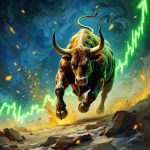Bull Markets Vs Bear Markets: The Intricate Dance
Updated Nov 18, 2023
The financial markets are like a dynamic battlefield where wisdom clashes with folly. Victory smiles upon those who adapt, learn, and strategize, while defeat often befalls those who stand rigid, unwilling to acknowledge the shifting sands beneath them. In this arena, terms like ‘bull’ and ‘bear’ markets are standard, denoting periods of rising and falling stock prices.
Savvy investors grasp that these labels aren’t mere abstractions; they represent distinct environments demanding different strategies. In a bull market, optimism fuels investments, propelling stock prices upward. Conversely, a bear market sees fear and pessimism driving the selling off of stocks and falling prices.
Yet, the financial landscape is not static. It evolves, sometimes subtly, sometimes dramatically, as witnessed with the introduction of Quantitative Easing (QE). This policy, a seismic shift in market dynamics, caught even seasoned watchers off guard.
QE departed from traditional market operations, challenging established indicators and strategies. Some experts clung to outdated models, akin to a captain steering towards an iceberg. Astute investors, however, recognized this as a new reality. They adapted, navigated the altered landscape, and reaped the rewards, understanding that mastering the markets means being flexible and responsive.
Those who adapt and learn thrive, while those who resist change are left with missed opportunities. The markets are unforgiving, but for those respecting their power and embracing complexity, they offer endless possibilities.
In investing, hubris finds no home. Claiming mastery invites humbling experiences. True market masters see themselves as perpetual students, turning bull markets into fortunes and navigating bear markets with minimal losses. They understand that in investing, change is the only constant.
Bull Markets Vs Bear Markets: The Art of Learning From Your Mistakes
In the intricate investing world, acknowledging and learning from one’s missteps is not merely a virtue; it’s an indispensable survival skill. With their complex dynamics and unpredictable nature, the financial markets can humble even the most seasoned investors. No one is immune to errors, but the distinction between successful investors and the rest often lies in their ability to learn from these blunders and adapt their strategies accordingly.
Albert Einstein, the renowned physicist, once defined insanity as doing the same thing repeatedly and expecting different results. This wisdom rings true in the financial markets. Investors who stubbornly adhere to failed strategies, refusing to acknowledge their mistakes, are bound to repeat them. This is a pitfall that many bearish experts and overly cautious bullish experts have succumbed to. Despite repeated failures, they persist in their attempts to short the market, seemingly oblivious that their approach is not yielding the desired results.
A shift in perspective could be the key to breaking this cycle of failure. What if we viewed the current market level not as a peak but as a midpoint on the journey to the full potential of this bull market? This change in perspective could unlock new profit opportunities. Instead of constantly trying to predict the next market crash, these investors could ride the bull market wave and lock in substantial gains.
However, no bull market lasts forever; a market downturn is inevitable. But by the time this happens, the bearish experts who have been predicting a crash for years may have already exhausted their resources. They may have missed out on the profits of the bull market and suffered significant losses from their unsuccessful short positions. In other words, by the time they are finally proven right, they may have already paid a steep price for their stubbornness.
This is not to say that caution and scepticism have no place in investing. On the contrary, they are essential tools for managing risk. However, they must be balanced with flexibility and a willingness to adapt to changing market conditions. Investors who cling to outdated strategies and ignore the lessons of their past mistakes will likely find themselves on the losing end of the market.
The Imperative of Adaptation in Investing: Evolve or Perish
The mantra “adapt or die” holds in financial markets. The markets are not static; they are dynamic and ever-changing entities requiring equally adaptable investors. This is especially important for those who plan to invest their money in these markets.
For example, the impact of Quantitative Easing (QE) on traditional market indicators and patterns has rendered them ineffective. Some of these patterns had been reliable for over a century, providing accurate signals. However, the introduction of QE disrupted these patterns, which was a wake-up call for investors. They realized they had to adapt to this new reality or risk becoming irrelevant.
The principle of mass psychology underlines the importance of adaptation in the markets. It suggests that they are destined to fail if investors don’t adapt and continue to follow the herd. The masses often operate on emotion rather than logic, leading to market bubbles and crashes. By breaking away from the herd and adapting to changing market conditions, investors can avoid these pitfalls and capitalize on opportunities others miss.
In response to the changes brought about by QE, investors invested significant time and resources into developing a new trend indicator. This required them to discard almost every other tool they had relied on for years. They stopped focusing on market internals, market volume, and hidden patterns, many of which had been used for decades, if not centuries. In the current market environment, these traditional tools are no longer effective.
However, this does not mean that this data is useless. On the contrary, it can still provide valuable insights if used differently. Investors plan to demonstrate this in the coming year by presenting tables illustrating up and down market volume. They pointed out that a spike in down volume during an upward trend could signal a good investment opportunity.
This brings us to the point that the debate over Bull Markets Vs Bear Markets is mainly irrelevant. What matters is the state of the masses. If the masses are in a state of panic, it presents a buying opportunity for the astute investor. Conversely, it may be time to sell if the masses are overly optimistic.
Crowd Psychology Undeniably Demonstrates the Imperative to Avoid Conformity
The subsequent excerpts extracted from prior Market updates (part of our premium service) vividly depict the consistent miscalculations of the market crowd.
So far in 2019, the number of individuals in the neutral camp has always surpassed those in the bullish or bearish camps, and this is very revealing. It clearly indicates that the masses are suffering from a long term bias and that the political landscape is messing with their ability to distinguish reality from fiction. Market Update March 31, 2019
The bull market is not dead that is the most important thing we want everyone to get from this update. If it were dead, we would be making alternative plans. The best signal that the bull market “is not dead” comes from the number of pending plays; if this bull market were dead, we would have very few plays on this list. The mass mindset is wired to react emotionally, and therefore it’s destined to fail. Market Update April 30, 2018
Logic has no place in this market; so focus on the emotional state of the crowd. Until the masses turn bullish, the very most we can expect from this market is a strong correction which will prove to be a buying opportunity. In the short term, the path of least resistance is still up. Market Update August 18, 2017
We would like to state that it now appears that the Dow will trade past 20K and could surge well over 25K. However, let’s focus on 20K and 21K for now. Market Update Nov 6, 2016
People expect the market to crash as Market sentiment is rather negative and hence it won’t. Our trend indicator is positive, and we have not seen a market crash when this indicator is bullish; that’s it. Market Update June 2, 2016
Indeed, the late bulls were skinned alive, and you can still hear their bellows; the bloodletting is not over. The markets (Shanghai Index) will rally for a bit, and then there should be one more down leg, to snap the backs of the semi-strong bulls. From a long-term perspective, we see nothing to worry about; everything is taking place as envisioned. The long-term trend is still up. Wait for some more blood to be spilt on the streets before taking larger bites. Market Update July 17, 2015
Bull Markets Vs Bear Markets: Avoiding the Tyranny of Arrogance and Fear
Financial markets are a mirror reflecting the rawest aspects of human nature. They are driven by emotions, oscillating between fear and greed, optimism and pessimism. This emotional undercurrent fuels the movements of the markets, making them a study in mass psychology.
Mastering the markets, therefore, begins with getting one’s emotions. It’s a challenging task, no doubt. Emotions are deeply ingrained in our nature, often influencing our decisions without conscious awareness. However, gaining control over these emotional impulses is crucial for successful investing. It’s a skill that requires practice and patience, but the rewards are well worth the effort.
Procrastination is a common obstacle in this journey. Many people promise that they will start making changes tomorrow, but when tomorrow comes, they repeat the same old patterns. The key is to understand that tomorrow begins today. Change is a process that starts with a single step taken in the present moment.
Historically, the masses have often found themselves on the losing side of the markets. This is not due to a lack of intelligence or ability but rather a failure to control their emotions. Market movements in recent years have been increasingly volatile, with wild swings and sudden shifts becoming the norm. This volatility can be disconcerting, even frightening, for those who let their emotions dictate investment decisions.
However, the focus should not be on the volatility itself or the endless debate between Bull Markets and bear Markets. Instead, the focus should be on identifying the prevailing trend. Once the trend is placed, it becomes a guiding light, illuminating the path forward.
In the end, successful investing is not about predicting every twist and turn of the market. It’s about understanding the emotional forces that drive the markets and learning to navigate these turbulent waters calmly and confidently. It’s about recognizing the trend and aligning your investment strategy with it. Most importantly, it’s about mastering your emotions and turning fear and greed into allies rather than enemies. This is the true art of investing, a journey that begins today.
The focus should not be on Bull Markets Vs Bear Markets but on identifying the trend. Once you know the trend, the rest is history.
The content was first published on January 2, 2018. It has been periodically updated over the years, with the most recent update conducted in Oct 2023.
Other Stories of Interest
Experts Making Stock Market Crash Forecasts usually know nothing
1987 stock market crash anniversary discussions- nothing but rubbish
Anxiety and Greed Index Don’t Support Stock Market Crash
Fed States Inflation is not an issue?
Is Bitcoin a Bubble or a Good Investment?















